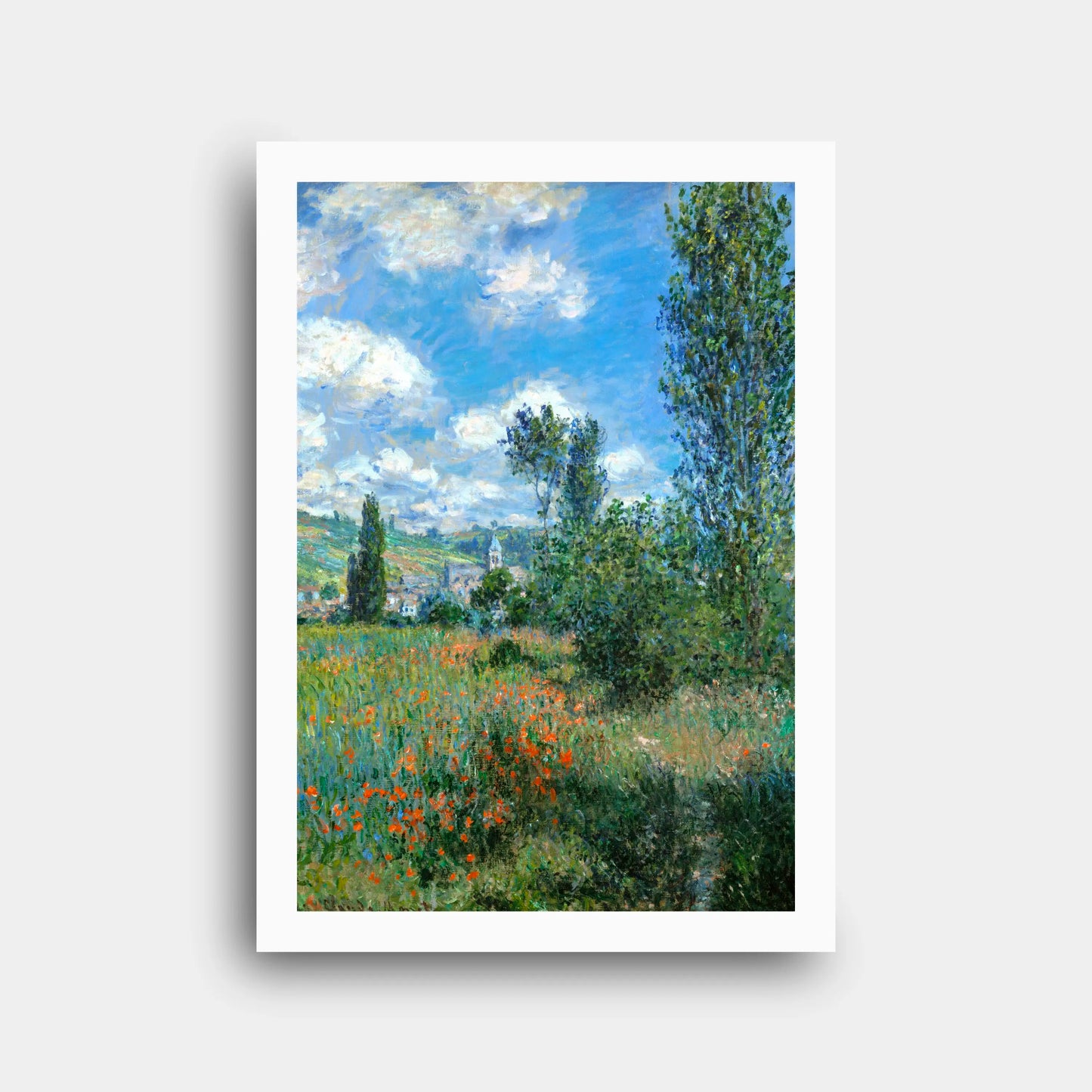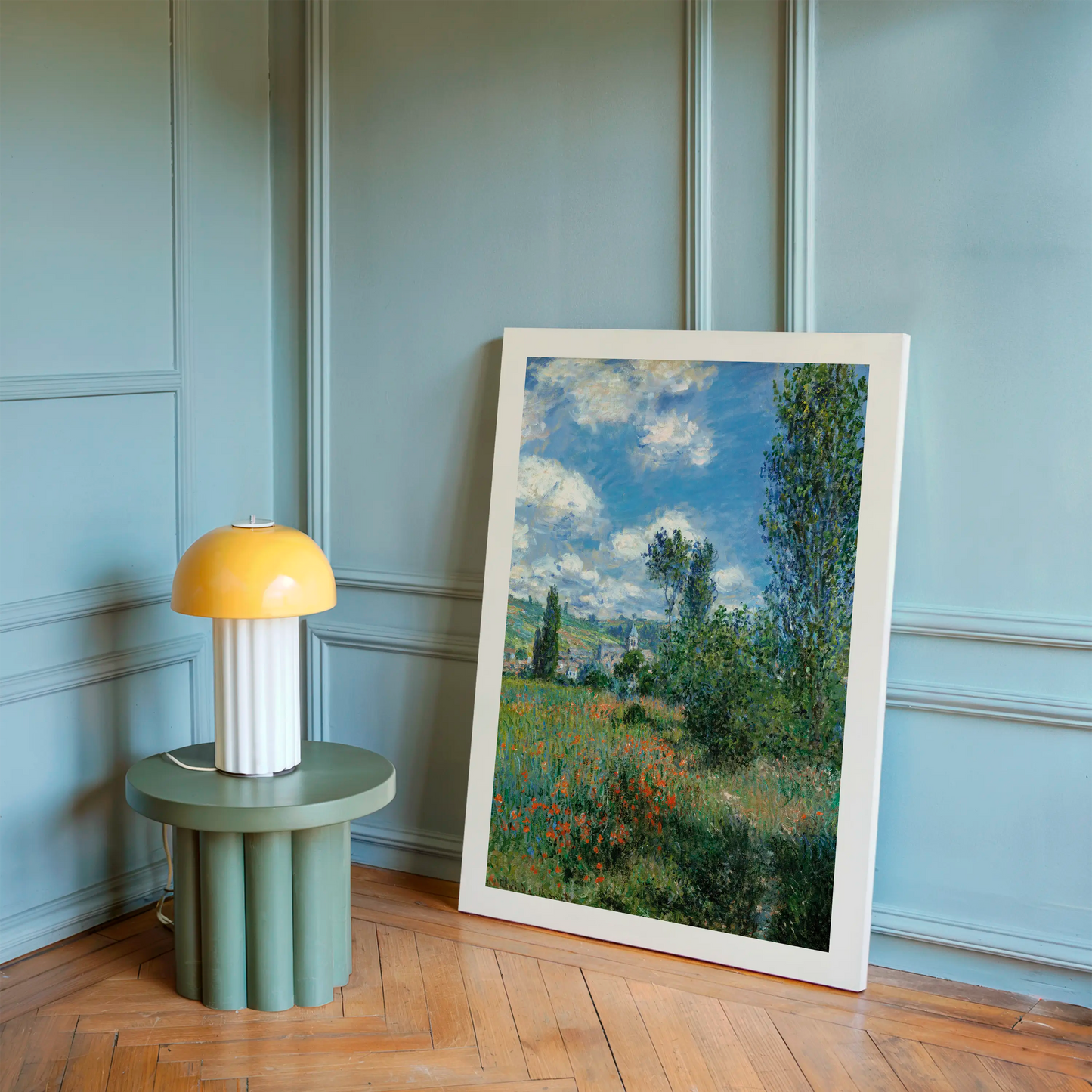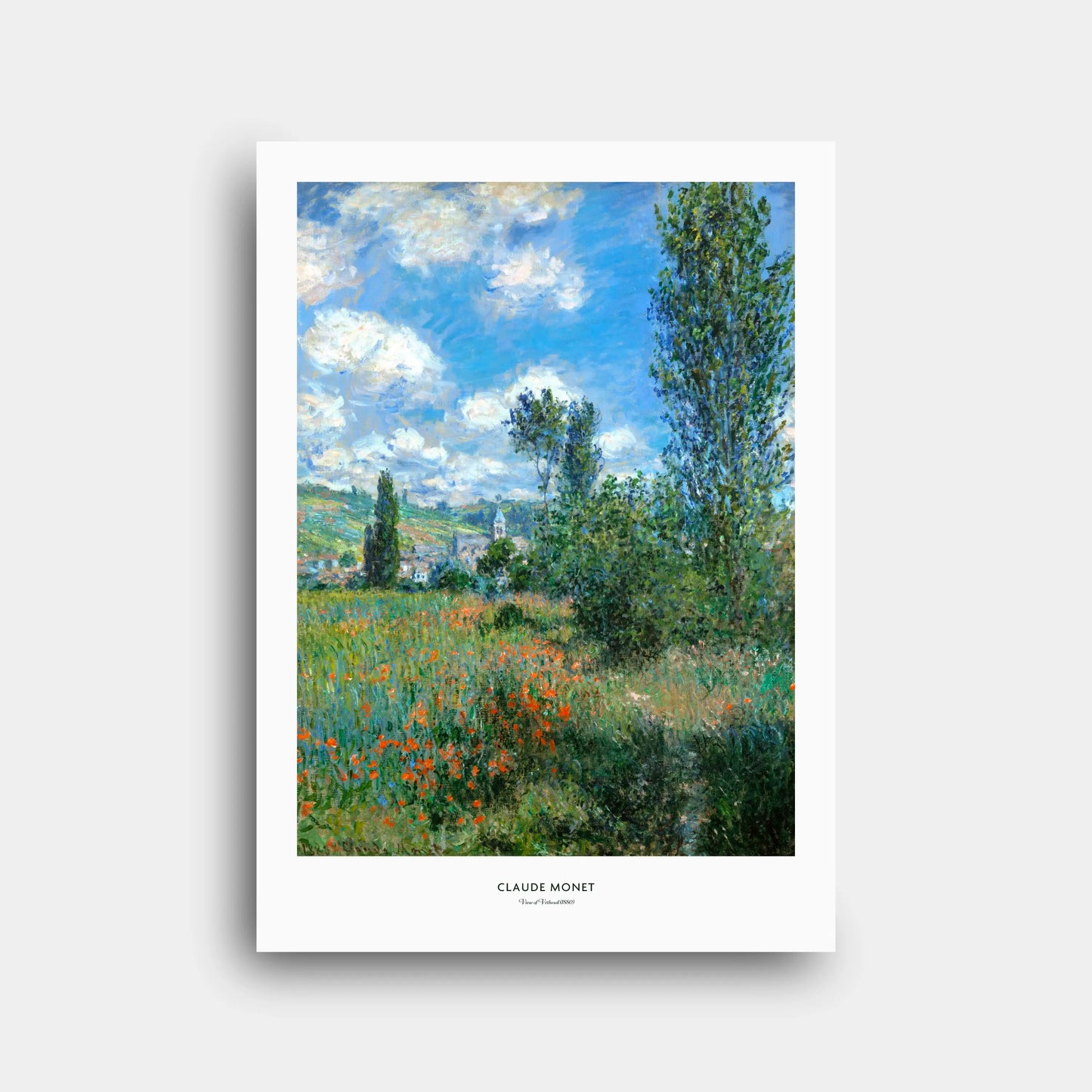Claude Monet - View of Vétheuil (1880) - Canvas Print N158
Claude Monet - View of Vétheuil (1880) - Canvas Print N158
Couldn't load pickup availability
Share
Paper Poster | Canvas Print | Digital File
1. Historical and Artistic Context
Claude Monet painted “View of Vétheuil” in 1880, during his stay in the village of Vétheuil on the banks of the Seine. This period followed the death of his wife Camille in 1879, a personal tragedy that coincided with financial difficulties. Despite hardship, Monet’s artistic output flourished, and he created numerous depictions of the village, the river, and the surrounding countryside. Vétheuil became a vital turning point in his career, where his focus on serial motifs and atmospheric light took root. The painting reflects Monet’s deepening interest in plein-air work and the shifting conditions of nature.
2. Technical and Stylistic Analysis
This canvas measures 80 by 60.3 cm and is vertically oriented, a striking choice for a landscape. Monet used verticality to emphasize the poplars rising against a vast summer sky. His brushwork is loose and dynamic, with rapid strokes of green, blue, and violet interwoven to create the shimmering sensation of light and air. The field in the foreground glimmers with strokes of red and orange poppies, their vibrancy heightened against the cool tones of grass. A path leads the viewer’s eye into the composition, guiding attention toward the distant church and houses. The sky, filled with billowing white clouds, anchors the work in a mood of freshness and vitality.
3. Symbolism and Interpretation
While Impressionism was not typically symbolic, Monet’s compositional choices carry deeper resonance. The path suggests a journey or transition from nature to civilization, inviting the viewer to walk toward the village and its church spire. The poppies, symbols of fleeting beauty and remembrance, add both warmth and poignancy to the scene. The towering trees act as guardians, linking the earth to the heavens, while the church tower represents continuity and tradition amidst the constant flux of natural life. Together, these elements express harmony between human presence and the natural environment.
4. Technique and Materials
Monet painted in oil on canvas, using quick and unblended brushstrokes that allow colors to vibrate optically in the viewer’s eye. His palette during this period typically included cobalt and ultramarine blue, viridian green, cadmium and chrome yellows, vermilion, and lead white. He applied paint directly and energetically, often layering distinct hues without mixing on the palette. This technique enhanced immediacy and conveyed the fleeting impression of a summer day. The vertical composition also reflects Monet’s experimentation with formats, emphasizing the dialogue between earth and sky.
5. Cultural Impact
“View of Vétheuil” holds cultural significance as part of Monet’s larger series of works painted in the village. These paintings anticipated his later serial explorations of haystacks, poplars, and water lilies. They influenced subsequent generations of artists who admired Monet’s ability to transform ordinary rural landscapes into visions of light and movement. The painting also entered prominent collections and exhibitions, shaping the international appreciation of Impressionism. Its presence in The Metropolitan Museum of Art underscores its role as an ambassador of French Impressionist innovation to a global audience.
6. Critical Reception and Scholarly Interpretations
Scholars regard the Vétheuil paintings as transitional works in Monet’s career. They show his move from suburban motifs of Argenteuil to more rural subjects. Critics highlight how these canvases demonstrate Monet’s emerging serial method—returning to the same view under different conditions to study changes in light and atmosphere. Art historians note that the verticality of this painting is unusual and deliberate, giving the scene a spiritual quality. The balance of village, church, and expansive natural surroundings has been interpreted as a visual metaphor for resilience and renewal during a time of personal loss for Monet.
7. Museum, Provenance and Exhibition History
The painting belongs to The Metropolitan Museum of Art in New York, where it entered the collection in 1956 through the bequest of Julia W. Emmons. Originally, Monet sold the painting in July 1880 to Charles Ephrussi, a Parisian collector and critic. It subsequently passed through several hands, including dealers Bernheim-Jeune and Durand-Ruel, before reaching American collectors. It has appeared in numerous exhibitions, including Impressionist retrospectives in Paris, New York, Vienna, and Stuttgart. Its exhibition history reflects the widespread appeal of Monet’s Vétheuil landscapes and their role in cementing his reputation internationally.
8. Interesting Facts (at least 10)
1. Monet painted this view from Île Saint-Martin, an island in the Seine near Vétheuil.
2. The river itself is hidden by trees, creating mystery and focus on land and sky.
3. The vertical orientation is rare in Monet’s landscapes of this era.
4. The painting is catalogued as W592 in Monet’s catalogue raisonné.
5. Monet sold the canvas to Charles Ephrussi for 400 francs in 1880.
6. A hole was once punctured in the canvas at The Met in 1966 and later repaired.
7. The church of Vétheuil, visible in the distance, is still a recognizable landmark today.
8. This work is part of a cluster of Vétheuil paintings in The Met’s collection.
9. Related paintings from this series were exhibited at the 1882 Impressionist exhibition.
10. The poppies in the field link this work to Monet’s earlier poppy-field paintings, creating continuity in his themes.
9. Conclusion
“View of Vétheuil” is more than a landscape; it is a meditation on light, place, and renewal. Painted at a time of personal hardship, it transforms the countryside into a vision of harmony and vitality. The verticality of the composition emphasizes both the rootedness of nature and the openness of the sky, suggesting resilience and hope. As part of Monet’s Vétheuil cycle, the painting bridges his earlier suburban works and his later monumental series. Today, it remains a luminous example of Impressionist innovation and a testament to Monet’s enduring quest to capture the poetry of fleeting moments.











